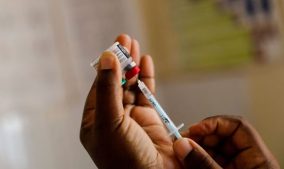Specialists at Tygerberg Hospital in Bellville, Cape Town, are using robots in their Intensive Care Units (ICU) in a bid to protect their healthcare workers from contracting the COVID-19 virus.
Meet “Quintin” and “Salma” – the two Double Robotic Robots. They look like Segway scooters with round wheels at the bottom and a long pole with an iPad on top.
They are being used by specialists to do virtual rounds in ICU wards where COVID-19 patients laying.
The specialist can also control the robots from home if they are unable to be physically present.
According to a statement by Stellenbosch University, the robots use gyroscope and accelerometer sensors in their base and can be controlled with a desktop, tablet or smartphone.
They enable communication between patient and doctor through a microphone and a zoom function and can relay vital signs of highly infectious patients.
“It doesn’t replace anybody”
A neurologist at the hospital, Prof Ian Vlok says the robots monitor blood pressure, the pulse of the heart, the amount of oxygen in the blood, and they can even review the settings on the ventilator.
Vlok says, “All patients in the very high risk ventilated area are actually fully monitored. They have all their cardiac monitoring and ventilator settings. All the monitoring is clearly visible. So what the robots actually do is, it doesn’t replace anybody, they provide the option of actually sending someone to have a look at these things. So they drive up and look at the settings and all the measurements and they relay them, without having to take one of the nursing staff, the doctors or whichever staff to be fully kitted up and to have to walk in there. So the human presence is not being decreased in anyway, it’s just added a whole lot of visits and potential visits to the bedside and at very low risk to anybody.”
Vlok says the hospital cannot afford to lose its critical staff members to COVID-19.
He says, “If a patient is positive they can infect the medical staff, the medical staff are at high risk… If you knock out one of the critical staff members, now suddenly the whole dynamic changes, for example, if the respiratory specialist is infected, these are people that are so super specialised in these ventilators. If you knock them out and they can’t be there, you’d actually put a detriment on the total service.”
However, he adds if any of the specialists where to be infected with the virus they would be able to work remotely using the robot, from a phone or a laptop.
‘Anxious hearts at ease’
Vlok says the atmosphere at the hospital is quite tense. “I think it highlights the vulnerability of the medical staff. Even though it (robot) might not make the biggest difference, at the end of the day it provides an option that puts a lot of anxious hearts at ease. You know you have a lot of nurses signing in, you’ve got physiotherapist that can signing in, so anybody in the team, it’s not limited to any specific person.
“It provides an option to manage anxiety. The atmosphere is quite tense, everybody is so aware of all the potential consequences. Now COVID-19 in its own right is not more risky than MDR-TB. But at the end of the day, it gives some assurance that at least we have some contingency in place.”
In the audio below, Prof Ian Vlok talks about the background of the robots:
Below is a video courtesy of Stellenbosch University of the Double Robotic Robots doing ICU ward rounds:






